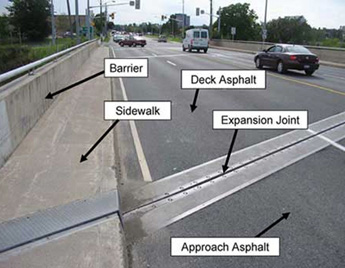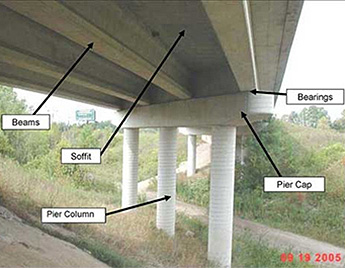Ontario is a leader in bridge safety. This page outlines what engineers look for when inspecting bridges and how bridges are repaired or replaced.
Keeping bridges safe
The Ministry of Transportation owns approximately 2,800 bridges. By law, the ministry conducts detailed inspections of all of their bridges every two years. The Ministry also conducts general maintenance inspections on all bridges at least twice a year.
A trained, professional engineer supervises all inspections. Bridge inspectors are trained engineers and technicians with several years of bridge-related experience. Inspectors must have taken the Ministry of Transportation bridge inspection course.
Experienced, professional engineers and inspectors must also follow the guidelines in Ontario's Structure Inspection Manual ( OSIM ). This manual provides inspectors with specific inspection procedures that must be followed during all bridge inspections
Bridge components
Inspectors carefully assess each part of the bridge and identify any maintenance work that needs to be completed. Each bridge component is rigorously examined to ensure that bridge remains safe for travel.
The bridge components that are assessed are as follows:



Bridge inspections
Detailed visual inspections
Detailed visual inspections are conducted every two years. During these inspections, inspectors:
- check the general condition of the bridge
- assess each bridge component and look for any problems with the bridge's concrete or steel materials
- identify what repairs are needed for each bridge component and if more testing is needed
- report any safety issues to supervising engineers and maintenance crews. In these cases, the inspector immediately calls in a repair crew to fix the problem
General maintenance inspections
Inspectors check the general condition of each bridge every spring and fall. If there is a safety issue, a repair crew is called in immediately to fix the problem.
Road patrol inspections
Maintenance teams regularly check that the bridge's roadway is safe. If there is any potential safety issue, the patrol will request a more detailed inspection.
Emergency inspections
A trained, professional engineer will check a bridge after any major event that might affect its safety, such as a collision, flood or earthquake.
Bridge test methods
Some of the common bridge tests include:
- External testing, using ultrasonic and magnetic particle tests. This type of testing helps the inspector determine if there is a crack that may not be seen by the human eye.
- Steel fatigue testing, using ultrasonic testing to check for cracks in places where steel parts are connected. Used on older steel bridges.
- Internal testing, using small samples of concrete or steel removed from the bridge. The samples are tested in a lab to check for strength.
- Bridge load capacity testing, using a special truck loaded with concrete blocks. The truck drives across the bridge while instruments attached to the bridge measure and record its movements. This measures how much weight the bridge can safely carry at one time.
Planning repairs
When a bridge is inspected in detail every 2 years, the trained inspector reviews and rates each bridge component. These ratings are used to determine the bridge's current value on the Bridge Condition Index.
The Ministry uses the Bridge Condition Index to plan maintenance and repairs. The index does not indicate the safety of a bridge.
The Bridge Condition Index
| Rating | Maintenance schedule |
| Good: BCI Range 70 -100 | Maintenance is not usually required within the next five years |
| Fair: BCI Range 60 -70 | Maintenance work is usually scheduled within the next five years. This is the ideal time to schedule major bridge repairs to get the most out of bridge spending. |
| Poor: BCI Less than 60 | Maintenance work is usually scheduled within one year. |
In some bridge inspections, inspectors may find chipped concrete or minor rusting on certain bridge components. This is the natural process of bridge aging. It does not affect bridge safety, since all concrete bridge components have reinforcing steel embedded in the concrete. While it may not look new, the bridge is safe.
Rapid bridge replacement
This innovative technology allows bridges to be replaced in a matter of hours, instead of months. Crews simply lift out the old bridge and replace it with a new one built nearby. The Ministry uses this approach wherever possible. Bridges replaced using rapid bridge technology include:
- Toronto - 401 off-ramp bridge at Yorkdale Shopping Centre (2012)
- Ottawa - Island Park (2007), Clyde Avenue (2008), Carling Avenue Eastbound (2011), Kirkwood Avenue and Carling Avenue Westbound (2013)
- Hamilton - Aberdeen Bridge (2010)
Benefits
- Reduces costs
- Improves site safety
- Reduces impact on the environment
- Reduces time the bridge is out of service and reduces traffic impacts
Frequently Asked Questions
Q1: What training do bridge inspectors have?
A bridge inspector must be a professional engineer or a technician with bridge inspection experience working under the direction of a professional engineer. Additionally, bridge inspectors working for the Ministry of Transportation must complete the Ministry of Transportation bridge inspection course.
During this course, inspectors are updated on what bridge components to inspect, how to inspect each component, how to identify a defect, how to record information from the inspection and how to make recommendations for bridge repairs. To ensure that these inspectors are up-to-date on the latest in bridge safety, they are required to attend this course every two years.